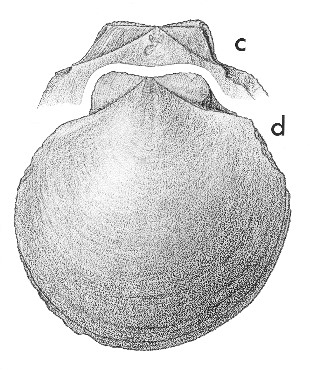
Revised descriptions of New Zealand Cenozoic Mollusca from Beu and Maxwell (1990)

 | Revised descriptions of New Zealand Cenozoic Mollusca from Beu and Maxwell (1990) | 
|
  (Pl. 10c, d): GS311, K36/f7499, "Curiosity Shop", Rakaia River, Canterbury, Waitakian (GNS) |
Beu & Maxwell (1990): Chapter 10; p. 144; pl. 10 c, d.
Synonymy: Pecten hochstetteri Zittel 1864, p. 50; Pseudamussium (Pecten) huttoni Park 1905, p. 485; Pecten (Camptonectes) huttoni
Type species of Lentipecten Marwick, 1928
Classification: Pectinidae
Description: Moderately large for family (height 55-75 mm), left valve more inflated than right, articulated specimens with well marked gape at each end, at and below ears. Ears subequal, separated from disc by shallow grooves; dorsal margins of left ears smooth, colinear, those of right valve slightly divergent, weakly serrate in some shells. Byssal notch shallow, fasciole flat or slightly convex. Both valves smooth except for weak growth lines, and exceedingly fine radial striae on some specimens. Cardinal crura well developed; auricular crura strongly tubercular distally. Adductor muscle scar much larger and situated in a more ventral position in left valve than in right.
Comparison: Lentipecten hochstetteri is one of the most widely recorded of all New Zealand Cenozoic molluscs and is readily distinguished from nearly all other local pectens by having both valves smooth (except for very weak growth lines and radial striae). Duplipecten parki (late Bortonian-Kaiatan) also has both valves smooth, but differs in having the right valve more inflated than the left (i.e., the opposite of L. hochstetteri) and in having deep channels separating the right valve ears from the disc.
The description given above and by Beu & Maxwell (1990, p. 144) was based on a broad, traditional concept of Lentipecten hochstetteri, i.e. one that includes all post-Whaingaroan pectens with both valves smooth, but it is now certain that two species, with quite different antecedents, are involved. Unfortunately, the type locality of L. hochstetteri has not been relocated (Fleming in Hochstetter 1959, p. 78, footnote 3) but the type specimen has now been examined and is relatively broad (slightly longer than it is high) and has an ill-defined, flat byssal fasciole. In these respects it closely resembles pectens from the Kokoamu Greensand in the vicinity of Duntroon, North Otago (Duntroonian). The right valve ears on Kokoamu Greensand specimens have finely serrate dorsal margins and some retain very faint traces of radial sculpture, but these characters are not well preserved on the type of L. hochstetteri. Olson & Fleming (in Gage 1957, p. 49) noted the similarity of Kokoamu specimens to L. hochstetteri, but because of the serrate and radially sculptured ears referred them to Janupecten subteres, even though they lack the weak radial sculpture on the disc characteristic of the latter species. It seems likely that the real Lentipecten hochstetteri evolved from J. subteres by continued loss of radial sculpture, and that Janupecten is a synonym of Lentipecten.
Pectens from the "Curiosity Shop", Rakaia River (Waitakian) — including the specimen figured here — closely resemble the Kokoamu shells but have much weaker serrations on the ears. Post-Waitakian Lentipecten-like shells, however, are noticeably higher than they are long, have almost smooth dorsal margins to the ears, and have a distinctly convex byssal fasciole. Very similar shells, differing mainly in their smaller maximum diameter, occur in a Bortonian shellbed in the upper Waihao River, South Canterbury, indicating that the smooth Neogene pecten is not descended from L. hochstetteri but has a quite independent origin in the upper Waihao River species. Therefore, it is now clear that the abundant, widespread, extremely well-known Neogene pecten traditionally identified as "Lentipecten hochstetteri" is an unamed genus and species. Further highly cryptic homeomorphs of these smooth "saucer scallops" probably also need to be distinguished in the New Zealand Paleogene fauna.
Distribution: Duntroonian-Waitakian?; "Aotea Sandstone" (not the lower Whaingaroan Aotea Sandstone of the type locality), coast north of Whaingaroa (Raglan) Harbour, Duntroonian (type locality of both P. hochstetteri and P. huttoni) and from greensand and limestone throughout New Zealand, but most common in North Otago-South Canterbury.
Cite this publication as: "A.G. Beu and J.I. Raine (2009). Revised
descriptions of New Zealand Cenozoic Mollusca from Beu and Maxwell (1990). GNS
Science miscellaneous series no. 27."
© GNS Science, 2009
ISBN
978-0-478-19705-1
ISSN 1177-2441
(Included with a PDF facsimile file
copy of New Zealand Geological Survey Paleontological Bulletin 58 in CD version
from: Publications Officer, GNS Science, P.O. Box 30368 Lower Hutt, New
Zealand)